Author: Ignas Source: ignasdefi Translation: Shan Ouba, Jinse Finance
It’s easy to be pessimistic about ETH right now. It has underperformed SOL 6.8x since the market low in early 2023, with ETH down 47% against BTC over the past two years.
Is it time to rebound?
Bearish case for Ethereum
The reasons for ETH’s poor performance are still controversial, but in my opinion, there are several important reasons:
Bitcoin is “digital gold” — a simple narrative that’s easy to understand, especially for new retail and institutional investors. Ethereum’s story, by contrast, is complex. The popular “digital oil” analogy is neither appealing nor accurate.
Solana is surpassing Ethereum: Solana is catching up to and sometimes surpassing Ethereum in terms of active users, transaction volume, and market share.
Therefore, BTC is the safer choice for cryptocurrency adoption, while Solana is the riskier (lower market cap) choice for smart contract adoption. Ethereum is sandwiched between the two.
Ethereum’s modular approach to L2s disrupts liquidity and complicates the user experience.
Degens staking on a modular approach spreads purchasing power across ETH beta tokens like multiple L2s, LRT tokens, and DA tokens. In contrast, staking Solana simply means buying SOL.
I believe ETH will outperform BTC as market participants recognize the high yield of airdrop farming rewards. In fact, my actual performance on ETH is far higher than the spot price suggests based on the re-staking protocol airdrop alone.
However, this failed to generate FOMO for ETH, probably due to overexposure during the bear market as many believed ETH would not fail and bought it heavily.
On the contrary, few people in cryptocurrencies hold SOL. When SOL rises, more native cryptocurrency users switch from ETH to SOL. Without a large influx of retail investors, the price of ETH stagnates.
Another issue is the declining ETH revenue and burn rates.
After the EIP-4884 Proto-danksharding upgrade, L2 payment fees dropped, resulting in a lower ETH consumption rate. Although ETH inflation remains below 1%, it is a setback for those who are bullish on ETH as an ultrasonic currency.
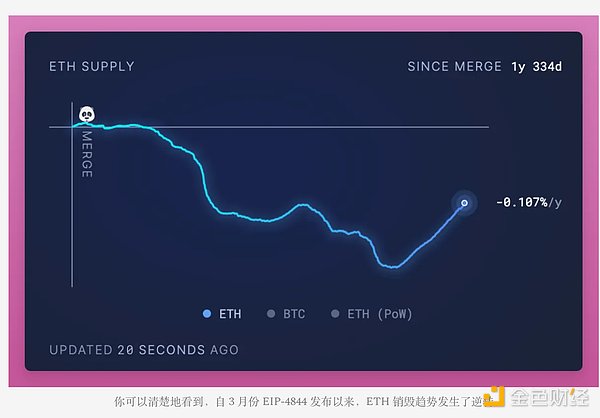
There are currently very few "Ultrasonic Currency" memes on Twitter.
Bearish arguments abound, but ETH sentiment remains bullish, albeit not as strong as BTC.
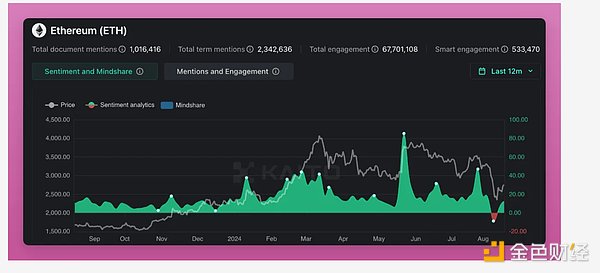
Instead, let’s discuss the bullish thesis for Ethereum.
Bullish arguments for ETH
There are many reasons to be optimistic about ETH. I asked my followers on X to share their views.
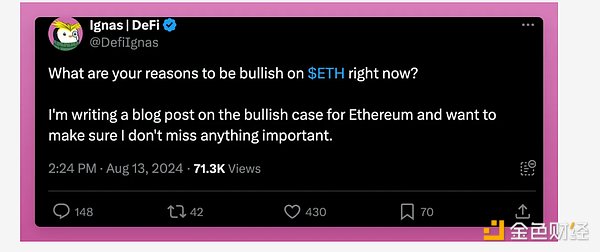
Feel free to check out the comments in the thread, but below I've summarized the top ten most important reasons mentioned (with the help of Kaito AI).
If gas prices remain around 20 gwei, Ethereum will be seen as both a deflationary and scalable network, making it an attractive and efficient network. Note: ETH gwei has been below 20 since March.
Regular users can now stake ETH individually from home, increasing its decentralization and attracting individual investors and validators with consumer-grade hardware.
The strong developer community and accumulated intelligence within the Ethereum ecosystem supports continued innovation and network robustness.
Ethereum is considered the leading smart contract platform with no real competitors, maintaining reliability and decentralization.
Continued developments such as Layer 2 and interoperability improvements are key bullish factors, while work is underway to reduce fragmentation and increase network efficiency.
Increased regulatory clarity, particularly in the U.S. and EU, has fostered confidence, allowing institutions like BlackRock to adopt Ethereum.
Improved staking options allow all ETH holders to participate in securing the network without requiring extensive technical knowledge or resources.
Major institutions such as Coinbase and BlackRock have stated that adoption of tokenizing real-world assets (RWA) on Ethereum is increasing.
The potential for expanded DeFi functionality and stablecoin dominance on Ethereum provides tremendous room for growth and market leadership.
The renewed enthusiasm and collective pride among Ethereum holders and users helped to create a positive outlook and increase market interest.
I also asked several notable ETH people on X why they are bullish on ETH. Those who responded to my questions included Camila Russo (founder of The Defiant) and Christine Kim (Galaxy researcher).
Here are the reasons why Camilla is bullish on ETH:
Mature DeFi ecosystem: Ethereum and its layer 2 offer the most mature DeFi ecosystem in crypto in terms of total TVL and transaction volume. This level of liquidity and dapp concentration will attract more users to the point where activity will start to be reflected on layer 1 chains again, driving up gas fees and consuming more ETH. DeFi is key because finance is one of the few crypto use cases with meaningful product-market fit right now.
Decentralization and Security: Ethereum’s level of decentralization and security has led the world’s largest institutions to trust it as they join Ethereum: BlackRock has its BUIDL fund, PayPal has PYUSD, JPmorgan, Santander and other large banks are testing blockchain settlement and tokenization on Ethereum, etc. Large institutions that cannot risk blockchain downtime or validator/miner attacks and malpractices will continue to choose Ethereum. This will drive activity and prices.
ETH ETF: ETH is one of only two cryptocurrencies that U.S. institutional investors can invest in through ETFs, which will provide long-term support for ETH prices.
Christine Kim highlighted the network effect of Ethereum:
I think one of Ethereum’s main advantages over its competitors is its network effect. Ethereum is the oldest general-purpose blockchain (first-mover advantage) and has the largest developer mind share (strong community/ecosystem), both of which I think contribute to the value of the network.
Indeed, I prefer to store long-term assets on Ethereum. Solana has had multiple outages, while Ethereum has proven to be reliable over the years.
I am also very bullish on Ethereum as an RWA chain for asset tokenization. For example, 52% of stablecoins and 73% of US Treasuries are tokenized on Ethereum.
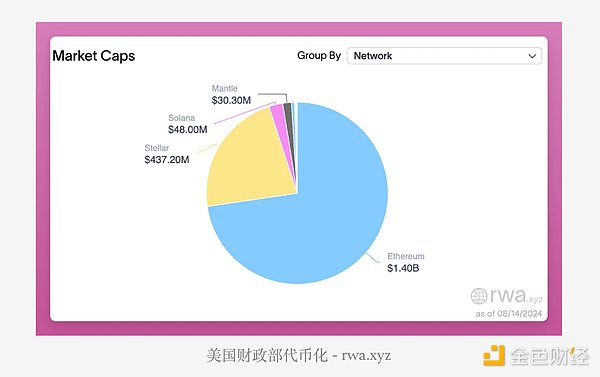
If you’re bullish on memecoins, Solana might be your choice, but for tokenizing billions of dollars in RWA, Ethereum is the safest place to be.
Next, a big question is the Layer 2 issue.
Solana as an overall chain is fast and cheap, but it still has its limits.
Modular scaling using L2 provides a long-term solution, as scaling can always be increased by launching L2 for specific use cases. L2 provides more flexibility, simplicity, and room for cultural sovereignty. Cygaar puts this point well in the following post:
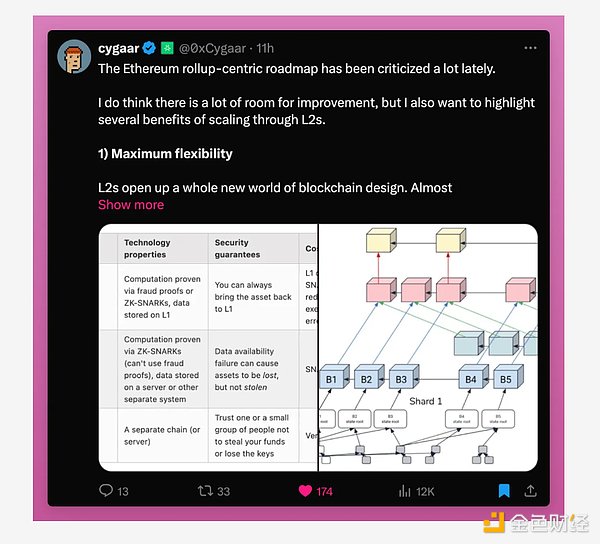
Hopefully, the current issues with fragmented liquidity and a poorer user experience due to reliance on bridges are only temporary issues. For example, Catalyst AMM will allow atomic swaps between different chains — eliminating the need for bridged assets. In this case, liquidity is still fragmented, but end users will still get the best price because liquidity comes from multiple chains. More solutions like Catalyst are in the pipeline.
Then L2 itself also made more efforts.
Optimism is “integrating with ERC-7683 to allow interoperability between the superchain and the rest of Ethereum L2 via the application layer,” meaning all L2s in the Optimism ecosystem will act like one.
Likewise, Polygon is building an AggLayer, which means “one-click transactions across chains. It will reproduce the online experience, but within the protocol network.”
There are also Caldera's Metalayer, Avail Nexus and Hyperlane.
Multiple aggregation solutions are also a problem, but liquidity and user experience issues should be resolved in the future.
I think people underestimate how quickly it's happening. I recommend following Andy on X to stay up to date on modular extensions.
In fact, Vitalik himself said that people would be surprised that “cross-L2 interoperability issues” are no longer an issue.
I would be very optimistic if L2 fragmentation issues are resolved and RWA and tokenization adoption continue to grow on Ethereum, but these are long-term factors.
In the short term, there is a little discussed catalyst: the Pectra upgrade.
What is Pectra Upgrade?
The Pectra upgrade is the next major milestone for Ethereum and is expected to be launched in Q1 2025. It merges the Prague (execution layer) and Electra (consensus layer) updates.
All major Ethereum upgrades have been hyped up before, but Pectra doesn’t seem to have caught the attention.
I understand why. Ethereum has undergone major changes: migration from PoW to PoS, ETH burn initiated, and EIP-4884, etc. However, Pectra has some cool upgrades.
1. Account abstraction: ultimately improving user experience
One of the biggest changes to Pectra is the way it handles accounts.
Currently, managing a wallet involves a lot of annoying steps, from signing transactions to managing gas fees for different networks. With account abstraction, Pectra simplifies the entire process.
EIP-3074 and EIP-7702 are two proposed improvements. EIP-3074 allows traditional wallets (externally owned accounts or EOAs) to interact with smart contracts, such as enabling batching and sponsored transactions.
EIP-7702 goes a step further and allows an EOA to temporarily act as a smart contract wallet for the duration of a transaction. Temporary means that your EOA wallet becomes a smart contract wallet only for the duration of the transaction. It works by adding the smart contract code to the EOA address. WTF? Anyway, I wanted to see it in action.
In practice it means:
Approve USDC and redeem UNI in one transaction.
dApps can provide gas fees to users (easier adoption)
Pre-approve dApps to be used with this wallet and set spending limits
NOTE: It appears that EIP-3074 has been preempted by EIP-7702, which Vitalik wrote in 22 minutes! EIP-7702 is also compatible with future implementations of AA.
This “EOA temporarily becomes a smart contract” approach is cool, as current dApps are generally not compatible with smart account wallets (try using Safe or Avocado multi-signature with a dApp). Hopefully AA will get more attention after the upgrade.
2. Improvements to equity pledge
For those running validators, Pectra brings some big changes.
EIP-7251 increases the maximum stake of a validator from 32 ETH to 2048 ETH. It allows large stake providers to consolidate their stakes, thereby reducing the number of validators and alleviating the network load.
This is also a benefit for smaller stakers as it provides more flexible staking options (you can stake 40 ETH or compound rewards). In addition, the ETH staking queue time will be reduced from hours to minutes.
One big thing I'm excited about has to do with MEV mitigation, but it doesn't seem to be available for the Pectra upgrade.
3. Scalability Improvements
Pectra introduced Peer Data Availability Sampling (PeerDAS) through EIP-7594.
Like Proto-Danksharding in the previous Dencun upgrade, PeerDAS will bring cheaper transactions on L2. But I can't find a number on how much cheaper it will be (I assume PeerDAS will be particularly useful during peak usage). 0xBreadguy mentioned that Pectra will increase blob capacity by 2 to 3 times.

Then there are multiple technical upgrades like BLS12-381 for shorter BLS signatures (reducing gas costs), and EIP-2935 for verifying transactions without needing all of the blockchain history.
These EIPs, along with Verkle Trees Transition (EIP-6800), which will eventually replace the existing Merkle Tree structure, can make light clients more secure and make it easier for nodes to participate in the network, thereby increasing decentralization.
One of the major changes is the 11 EIP changes to the EVM, which will make it easier to write and deploy smart contracts, thereby reducing costs and increasing efficiency. In other words, development on Ethereum will become smoother.
I'm glad that Single Slot is finally (SSF) coming out with the Pectra upgrade, but it's not yet included in the following Osaka upgrade.
Vitalik shared in December 2023 that SSF is the simplest way to solve most of the flaws in Ethereum PoS design.
Currently, Ethereum’s proof-of-stake consensus takes about 15 minutes for a block to reach finality, meaning that the block cannot be changed or deleted without a huge economic cost. SSF seeks to reduce this time to one slot, or about 12 seconds, ensuring that blocks are finalized almost immediately after creation.
In practice, this means faster and more secure bridges, and faster CEX deposits. It is disappointing that this has not happened yet. Leaving it out of the upgrade is pessimistic and shows that Ethereum developers are still not prioritizing L1 scaling. I would be more optimistic if there were more clear signs that the core ETH community is focusing on L1 scaling. At the moment, it does not seem to be a priority.
Regardless, Pectra is a technology upgrade, but I think the market is underestimating its significance.
Now, let’s talk about ETH price.
VanEck’s base case price prediction for ETH is $118,000 by 2030.
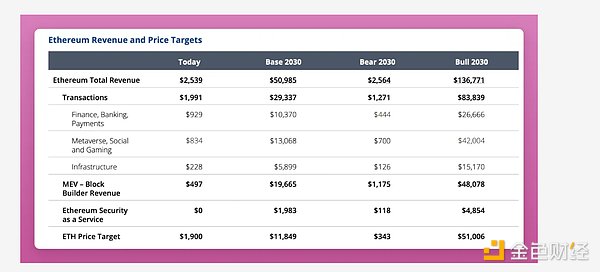
Honestly, $118k is pretty pessimistic (I expect it to trade higher in 5 years), but keep in mind that VanEck’s base case forecast for Solana in 2030 is only $335.
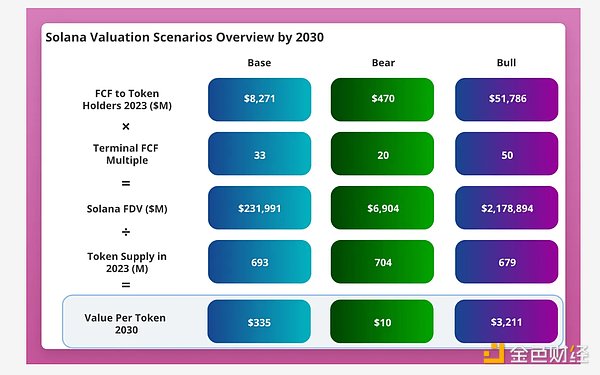
Therefore, based on the base case forecast, ETH has a potential gain of 4.4x, while SOL has a potential gain of only 2.2x. Note that both of these forecasts were shared over a year ago (before the ETH ETF was launched), so it would be interesting to see their updated forecasts.
However, I am more excited about the bullish prospect of ETH reaching $51,000. Anyway, VanEck’s ETH price prediction is based on:
VanEck predicts that by 2030, Ethereum will have a 70% market share of smart contract platforms, leveraging its position as the dominant open-source global settlement network.
Ethereum revenue is expected to grow from $2.6 billion per year to $51 billion by 2030. This growth is attributed to the increase in transaction fees, MEV, and the introduction of “security as a service” (SaaS) - using ETH to secure other protocols (restaking).
Ethereum is expected to attract more economic activities in the fields of finance, banking, payments, metaverse, social, gaming, and infrastructure.
Ethereum is valued for its potential as a store of value asset, with its utility enhanced by smart contract programmability and cross-chain messaging technology (smart collateral).
Below is a summary of the base case, bear case, and bull case scenarios.
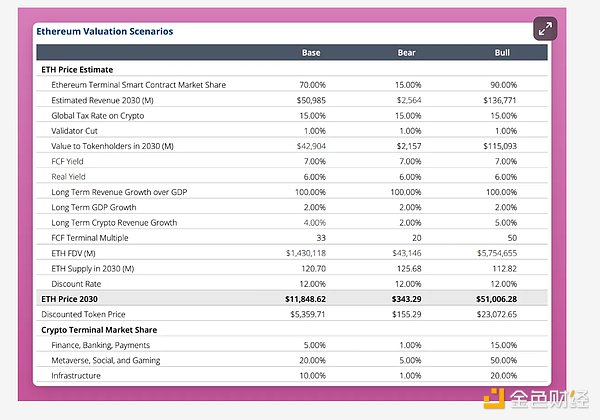
The base case scenario of 70% smart contract dominance seems pretty fair to me, even though Ethereum’s dominance is only 58% right now (but all L2s are around 65%). Dominance has remained the same since early 2022, despite SOL’s crazy run-up.
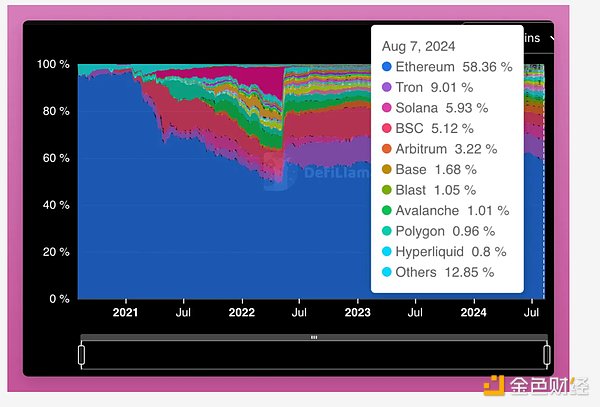
TVL dominance will be a key metric to watch as institutions really seem to care about it.
Another metric that both institutional and retail investors watch is ETH ETF flows.
Ethereum ETF
If someone had told me a few months ago that ETH had an ETF but was trading below $3,000, I would have thought crypto was in a bear market.
It's too early to tell, but the ETH ETF seems to be getting more bullish every day. Grayscale outflows have been falling fast, and net flows have been positive for three consecutive days. It looks like those who needed to exit Grayscale have already done so.

We already know how big of an impact Grayscale can have, but the upside potential will be a pleasant surprise. If the trend continues, the future looks bright for ETH!
Given everything that’s going on with Ethereum, are you still bullish on it?






